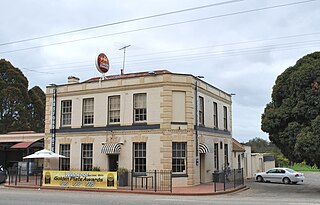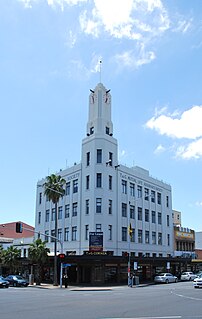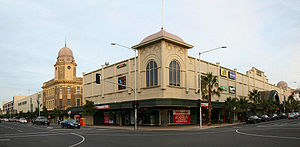Geelong is a port city in the southeastern Australian state of Victoria, located at the eastern end of Corio Bay and the left bank of Barwon River, about 65 km (40 mi) southwest of Melbourne, the state capital of Victoria.

New Street is a street in central Birmingham, England. It is one of the city's principal thoroughfares and shopping streets linking Victoria Square to the Bullring Shopping Centre. It gives its name to New Street railway station, although the station has never had direct access to New Street except via the Grand Central shopping centre through Stephenson Street.

Fyansford is a township on the western edge of Geelong, Victoria, Australia, named after Captain Foster Fyans who came to Geelong as a Police magistrate in October, 1837. It is located at the junction of the Barwon and Moorabool rivers. At the 2016 census, Fyansford had a population of 196.

Norlane is a northern suburb of Geelong, in Victoria, Australia. Norlane is bordered in the south by Cowies Creek, in the north by Cox Road, in the west by Thompson Road and in the east by Station Street. It is about 7 km from the Geelong central business district and approximately 70 km from the state capital, Melbourne. It is about one kilometre from the shore of Corio Bay. At the 2016 census, Norlane had a population of 8,306.

South Geelong, also referred to as Geelong South, is a southern suburb of Geelong, Victoria, Australia. Its local government area is the City of Greater Geelong. At the 2016 census, South Geelong had a population of 993.

Kitchener City Hall is the seat of municipal government of Kitchener, Ontario, Canada. It has gone through many iterations through the 20th century, culminating in the current building, which opened in 1993.

Leicester City Centre is Leicester's historical commercial, cultural and transport hub and is home to its central business district. Its inner core is roughly delineated by the A594, Leicester's inner ring road, although the various central campuses of the University of Leicester, De Monfort University and Leicester College are adjacent to the inner ring road and could be considered to be a continuation of the City centre. In a similar way, the Leicester Royal Infirmary precinct, the New Walk business district (Southfields), the Welford Road Stadium of Leicester Tigers' RUFC and the King Power Stadium of Premier League Leicester City to the south, and the Golden Mile to the north could also be deemed to be extensions to the central core.

The Haymarket Memorial Clock Tower is a major landmark and popular meeting point in Leicester, United Kingdom. It is located roughly in the middle of the area inside the ring-road, and is at the point where five major streets meet; Gallowtree Gate, Humberstone Gate (A47), Haymarket (A607), Church Gate (A6) and Eastgates (A47).

Westfield Geelong is a shopping centre located in the Geelong CBD in Victoria, Australia which was opened in 1988. It was formerly known as Westfield Bay City before the 2008 redevelopment, and as Bay City Plaza before being acquired by the Westfield Group in 2003. The centre is located on the northern side of Malop Street opposite the Market Square shopping complex, and is bounded by Moorabool Street, Yarra Street, Malop Street and Brougham Street. The centre has completed its major redevelopment, including the expansion over Yarra Street via a flyover.

Corio Oval was an Australian rules football ground, located in Geelong, Victoria, and used by the Geelong Football Club in the VFA and the VFL from 1878 to 1915, and 1917 to 1940. Sited in Eastern Park, the oval was served by trams from 1930 when the line was extended along Ryrie Street to the football ground.

Geelong Town Hall is a civic building located on Gheringhap Street in central Geelong, Victoria. It was originally built for the City of Geelong, which became the City of Greater Geelong in 1993.

Market Square Shopping Centre is located in Geelong, Victoria, Australia. The shopping centre was named after the original town square of Geelong on which the shopping centre is constructed. The centre is surrounded by Little Malop, Moorabool, Malop, and Yarra Streets. Market Square is located on the southern side of Malop Street opposite the Westfield Geelong shopping complex, the two of which together make up Geelong's Central Shopping Complex.

The T & G Building is a distinctive building in Geelong, Victoria, Australia. It is located on the corner of Moorabool and Ryrie Streets. The building's style is a blend of Art Deco and Classicism. Both of these styles can be noted in the buildings geometric grooves, vertical lines and stepped form. The exterior of the ground floor features chevron grill patterns, a feature that is particular of Art Deco archicture.

The Geelong Art Gallery, currently known as Geelong Gallery, is a major regional gallery in the city of Geelong in Victoria, Australia. The gallery has over 6,000 works of art in its collection. The Gallery forms Geelong's Cultural Precinct with the adjacent Geelong Library and Heritage Centre, Geelong Arts Centre, and the Geelong Courthouse.

Johnstone Park is a landscaped garden in Geelong, Victoria, Australia. It is bounded by Railway Terrace, Gheringhap Street, Little Malop Street, Fenwick Street, and Mercer Street. The park is surrounded by civic buildings including the Geelong Town Hall, Geelong Art Gallery, Geelong Library, Geelong Law Courts, and the Geelong Railway Station. A war memorial and bandstand feature in the centre of the park.

Geelong Arts Centre, formerly the Geelong Performing Arts Centre (GPAC), is a performing arts, functions, and events venue located in Geelong, Victoria, Australia. It is a Statutory Authority and was established by the Geelong Performing Arts Centre Trust Act 1980 No. 9406. Previously, the centre has two major theatres, a number of smaller performance spaces, and a bar, restaurant and cafe which have been temporarily closed during the redevelopment. It is located between Little Malop and Ryrie Streets in central Geelong.

The Geelong city centre is the urban center and main commercial locality of the Geelong metropolitan area, also referred to as the Geelong CBD, Central Geelong, the Central Activities Area, or informally simply as "Town" by locals. The name of the area is officially gazetted as Geelong.
Edward Prowse was an architect working in the Geelong region of Victoria, Australia in the late nineteenth century. He was responsible for many early Geelong buildings, including hotels, mansions and churches.
One of the first big businesses that developed in the new colony of Australia was the wool industry. It had an important impact on the development of Geelong as the centre of wool sales and exports. Geelong's location and the ambition of local merchants made it perfect for shipping Australian wool worldwide. As the industry boomed, throughout Geelong large storehouses were built for the storage, assessment, sale and transport of wool bales from throughout Victoria and even further.
Melbourne, the capital city of the state of Victoria, in Australia, has been described as an important Victorian era city, and has a wealth of buildings from the period, including public buildings like the State Library, Parliament House, and the General Post Office, the Royal Exhibition Buildings, and commercial buildings like the Windsor Hotel, the Block Arcade the Rialto Group, and the Gothic Bank. The inner suburbs are also largely Victorian, composed of terraced houses with cast iron lace, and streets of continuous shop-houses dotted with elaborate pubs, while beyond that are suburban areas of freestanding Victorian villas, and dozens of large, often towered, mansions.






















